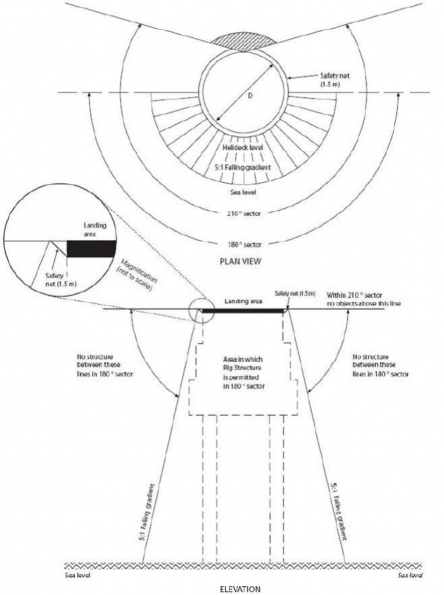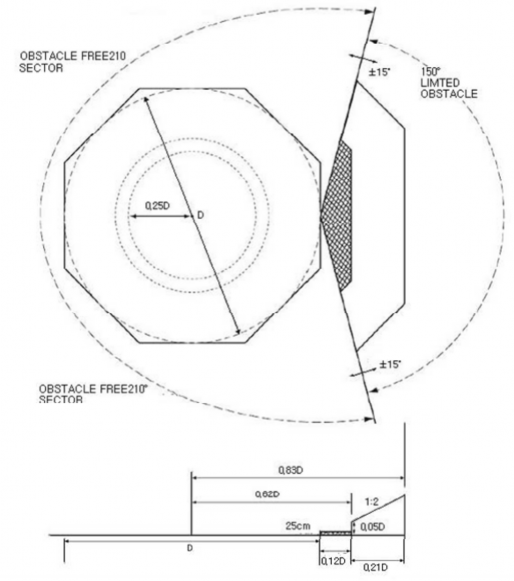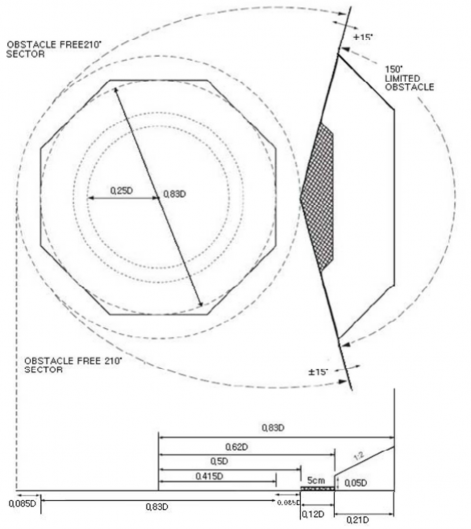

< Previous | Contents | Next >
Section 3 Construction
301. General
1. The helideck should be of a design and construction, adequate for the intended service and for the appropriate prevailing climatic conditions, approved to the satisfaction of the Society.
2. Except as provided for in Par 3, the helideck should meet the following provisions, with reference to the ICAO Convention, Annex 14, Volume II (Heliports), taking into account the type of heli- copter used, the conditions of wind, turbulence, sea state, water temperature and icing conditions:
(1) the helideck should be of sufficient size to contain an area within which can be drawn a circle of diameter not less than D for single main rotor helicopters;
(2) a helideck obstacle-free sector should comprise of two components, one above and one below
helideck level (see Fig 12.1):
(A) above helideck level: The surface should be a horizontal plane level with the elevation of the helideck surface that subtends an arc of at least 210° with the apex located on the pe- riphery of the D reference circle extending outwards to a distance that will allow for an un- obstructed departure path appropriate to the helicopter(s) the helideck is intended to serve; and
![]()
(B) below helideck level: Within the (minimum) 210° arc, the surface should additionally extend downward at a 5:1 falling gradient from the edge of the safety net below the elevation of the helideck to water level for an arc of not less than 180° that passes through the centre of the FATO and outwards to a distance that will allow for safe clearance from the ob- stacles below the helideck in the event of an engine failure for the type of helicopter(s) the helideck is intended to serve (see Fig 12.1);

Figure 12.1 – Obstacle free areas – below landing area level
![]()

Figure 12.2 Helideck obstacle limitation sector: single main rotor helicopters
(3) for single main rotor helicopters, within the 150° LOS out to a distance of 0.12 D, measured
from the
point of origin of the LOS, objects should
not exceed a height of 0.25 m above the
helideck.
Beyond that arc, out to a distance of an additional 0.21 D, the maximum obstacle
height is
limited to a gradient of one unit vertically
for each two units horizontally originating
at a height of 0.05 D above the level of the helideck (see Fig 12.2);
(4) objects the function of which requires that they be located on the helideck within the FATO
should be limited to landing nets (where required) and certain lighting systems and should not exceed the surface of the landing area by more than 0.025 m. Such objects should only be present provided they do not cause a hazard to helicopter operations; and
(5) operations by tandem main rotor helicopters should be specially considered by the Society.
3. For benign climates as determined by the coastal State, taking into account the type of helicopter used, the conditions of wind, turbulence, sea state, water temperature and icing conditions, the heli- deck should meet the following:
![]()
(1) the helideck should be of sufficient size to contain a circle of diameter no less than 0.83 D;
(2) a helideck obstacle-free sector shall comprise of two components, one above and one below helideck level (see Fig 12.1):
(A) above helideck level: The surface should be a horizontal plane level with the elevation of the helideck surface that subtends an arc of at least 210° with the apex located on the pe-
riphery of the D reference circle extending outwards to a distance that will allow for an un-
obstructed departure path appropriate to the helicopter(s) the helideck is intended to serve, and
(B) below helideck level: Within the (minimum) 210° arc, the surface should additionally extend
downward at a 5:1 falling gradient from the edge of the safety net below the elevation of the helideck to water level for an arc of not less than 180° that passes through the centre of the FATO and outwards to a distance that will allow for safe clearance from the ob- stacles below the helideck in the event of an engine failure for the type of helicopter(s) the helideck is intended to serve (see Fig 12.1);

Note: Heights of 2.5cm and 5cm high shaded areas are not to scale
Figure 12.3 Helideck obstacle limitation sector: single main rotor helicopters for benign climate conditions as accepted by the coastal State
![]()
(3) for single main rotor helicopters, within 0.415 D to 0.5 D objects should not exceed a height of 0.025 m. Within the 150° LOS out to a distance of 0.12 D, measured from the point of ori- gin of the LOS, objects should not exceed a height of 0.05 m above the helideck. Beyond that arc, out to a distance of an additional 0.21 D, the LOS rises at a rate of one unit vertically for each two units horizontally originating at a height of 0.05 D above the level of the helideck (refer to figure Fig 12.3);
(4) objects the function of which requires that they be located on the helideck within the FATO should be limited to landing nets (where required) and certain lighting systems and should not exceed the surface of the landing area by more than 0.025 m. Such objects should only be
present provided they do not cause a hazard to helicopter operations; and
(5) operations by tandem main rotor helicopters should be specially considered by the Society.
4. The helideck should have a skid-resistant surface.
5. Where the helideck is constructed in the form of a grating, the underdeck should be such that the ground effect is maintained.